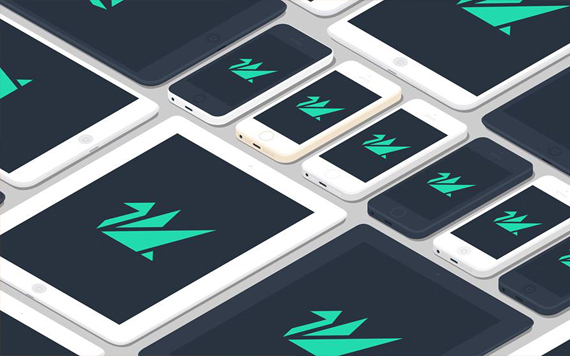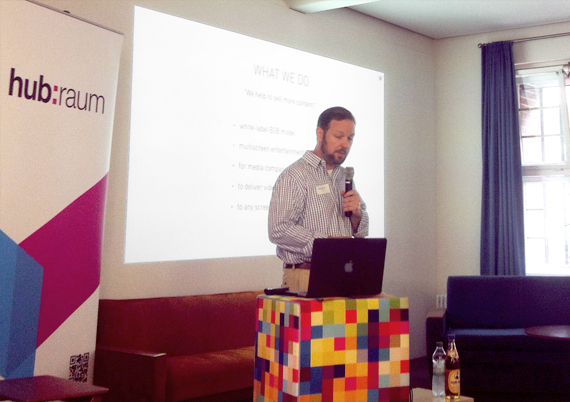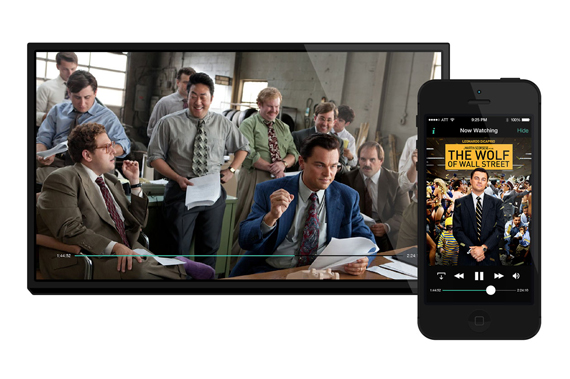Today we start a new series on brandnewthinking.de: From now on we will introduce interesting startups and speak with them about the role of design and brand management during the founding phase.
Our first startup is Vigour, a company for innovative multiscreen video services. Their product Vigour video helps media companies offer a new kind of video experience — without the usual boundaries of TV, tablet or smartphone. Their white label interface solution merges the screens of any combination of devices into a fluid multiscreen experience and makes them behave like a single interface. For example, a tablet can serve as a second screen to browse related content or future episodes of your favorite TV series that is running on your big screen. At the same time, your phone serves as a remote control and social media hub. Shows can be picked up anytime anywhere on any device and you pick up right where you last left off.
We met Vigour COO Leo Schmidt at the hub:raum Portfolio days in Berlin for an interview on design and development at startups and the relevance of brand building during the founding phase.
Vigour COO Leo Schmidt pitching at the hub:raum portfolio days.
What is the idea behind Vigour video?
„Vigour video is a solution to create multiscreen experiences for online video services. The idea emerged when we were challenged with an innovation task at a large telco company to create a set top box based interface that would connect to all other devices in the household. We stumbled over a million problems to be solved to come up with a true multiscreen interface where any device can join a content interaction experience. We solved those problems by building the first version of our Vigour technology platform. That platform is the driver behind our Vigour Video product today.
With our white-label product approach we‘re able to deliver multiscreen video solutions in a fraction of time and in a fraction of budget to media companies and operators that are looking for innovative models to monetise their video content.“
Additional screens can be used to create innovative multiscreen scenarios such as displaying supporting content or engaging users in interactive experiences.
What was the main driver for founding your own company?
„The idea to build a business around that technology came up in the summer of 2012 when the original founder team had discovered the power and potential of its technology platform. They decided to apply to the Startupbootcamp acceleration program in Berlin to build a stronger international network and to get the business off the ground faster. I was a mentor at Startupbootcamp at that time and met many very interesting teams. But no team excited me as much as these guys. During this acceleration phase we formed our team with just the perfect match of skills, vision, design, technology, product and company building.
Coming out of Startupbootcamp we had very good feedback from the investor community. We then raised our seed round with T-Venture/hub:raum in may 2013, built our first product, went to the market and acquired the first customers. We are now in the good position to really have some proof points that we picked the right product in the right market at the right time and we’re slowly switching into growth mode now.“
Do you now also have other investors?
„There’s two main investors: Telekom’s hub:raum/T-Venture are in the lead with about half of that seed round. The other half is mainly supported by Linden Mobile, a dutch tech VC, but our advisors also contributed with smaller tickets. We are very happy with this mix and have a great relation to all of them. Besides the money, all our shareholders significantly add value to the growth of our company, all in their own way.“
In your opinion, how important is UX- and Visual Design to Vigour video?
„User experience design is just as important to us as the technology it runs on: Our technology platform is cutting edge and enables us to deliver a new and disruptive product. But making this multiscreen interaction intuitive and valuable for the end-users of our customers’ video services requires a deep understanding of user behavior and UI design.
We ultimately convince our customers with the combination of experience & vision to unlock a new kind of multiscreen interaction.
Of course our technology is cutting edge and gives us unique market- and product opportunities. But there’s big players out there, all beginning to create multiscreen capabilities. I believe it’s just a matter of time until technology becomes replaceable. Then the combination of relevant features, design and technology will make the difference. “
What is the design process at Vigour like?
„It is a very agile but not very structured process. We’re not big fans of a scrum based or predefined process. We’re trying to understand the vision, the business- and distribution models of our clients and the challenges they face in the transforming media industry. Then we translate that into a product or solution that best supports their vision. Usually we come up with stuff they didn’t ever think of and sometimes trigger some challenges for them internally. Those challenges can be in their existing partnerships, in the licenses for the content they wish to distribute, in their subscription models, advertising deals and so on. But we keep pushing hard to create unique, mind blowing and highly addictive experiences for their users. Sometimes that requires change on our customers side but we encourage them to step out, to go that extra mile and to keep it awesome.“
Devices can be used to engage with context relevant content— in Vigour devices change roles very naturally and intuitively.
Do your customers embrace those innovations or are they reluctant?
„They embrace it and they’re scared at the same time. We both know this kind of innovation impacts the core of their business. So if they’re a media company that commercializes video content, we definitely change the way they deliver their service and the way they interact with their customers. It creates a whole bunch of new opportunities but it requires focus. So it’s a challenge for them and us at the same time. What we offer is so new and we cannot look back on other cases as reference points of what worked and what did not.
We cannot give guarantees on percentage of uplift in consumption, revenue or guarantee desired changes in user behavior. We create something sexy, cool and new that people really want.
How that will turn out in detail, no one really knows just yet. But we are convinced it has the potential to truly change the way we all use our devices to interact with digital content.“
From your experience, what is the impact of a brand to a start-up?
„We try to connect the brand to the quality of the experience we provide. So we keep it very simple and clean. We want people to connect our brand to simplicity in something that’s usually difficult to do: use multiple devices to discover and enjoy cool content. So in our case I would say our brand is a critical asset and we take every step in building that brand very seriously and very carefully.
There may be other areas however, where the brand is not as critical. There are real crappy brands out there for awesome products. So I wouldn’t say the brand alone wins the game but it definitely helps and it’s worth taking seriously.“
Linkliste:



